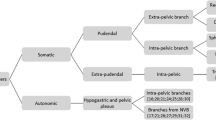Abstract
Radical prostatectomy is commonly used in the management of localized prostate cancer. Urinary incontinence after prostatectomy is of great concern to many patients. Improved understanding of the anatomy of the external urethral sphincter complex has resulted in a statistically significant decrease in the incidence of postprostatectomy incontinence. Most recent anatomic studies have described the external urethral sphincter complex as consisting of an intrinsic rhabdosphincter surrounding the smooth musculature of the urethra and an extrinsic sphincter incorporating the levator ani muscle and the pelvic floor. Both form a condensed striated muscle ring around the membranous urethra. Preservation of as much as possible of the normal anatomy of the sphincter mechanism and its nerve supply results in an excellent return to continence after radical prostatectomy.
Similar content being viewed by others
Author information
Authors and Affiliations
Additional information
Received: 26 February 1999 / Accepted: 20 May 1999
Rights and permissions
About this article
Cite this article
Heinzer, H., Hammerer, P. & Huland, H. Anatomy and physiology of the male urethral sphincter and its preservation in prostatic surgery. Urological Research 27, 404–408 (1999). https://doi.org/10.1007/s002400050128
Issue Date:
DOI: https://doi.org/10.1007/s002400050128




